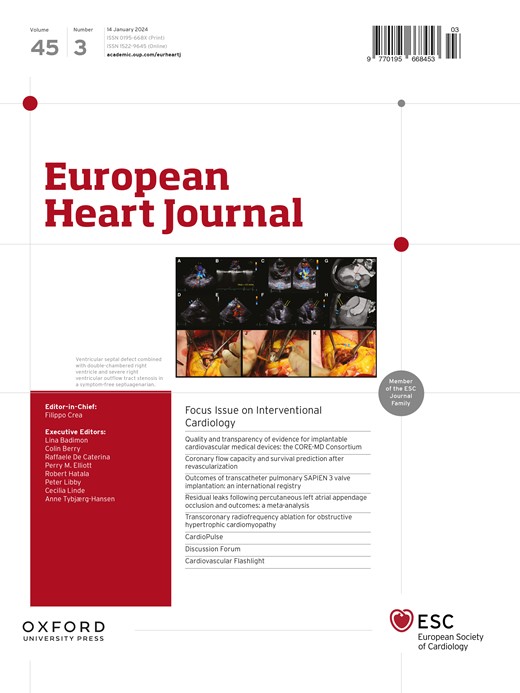Outcomes of moderate mixed aortic valve stenosis and regurgitation.
IF 35.6
1区 医学
Q1 CARDIAC & CARDIOVASCULAR SYSTEMS
引用次数: 0
Abstract
BACKGROUND AND AIMS There are limited data on mortality in patients with moderate mixed aortic valve disease (MAVD), defined as the combination of moderate aortic stenosis (AS) and moderate aortic regurgitation (AR). Consequently, current guidelines lack specific recommendations for aortic valve replacement (AVR) in this population. This study aims to compare survival between moderate MAVD and isolated severe AS or severe AR, and to evaluate the impact of symptoms or left ventricular ejection fraction (LVEF) < 50%, as current criteria for AVR in severe AS or AR. METHODS Overall, 1926 patients were included from four centers: 527 with moderate MAVD, 413 with severe AR, and 986 with severe AS. The primary endpoint was all-cause mortality. RESULTS Over a median follow-up of 7.2 (interquartile range 3.4-11.3) years, 748 patients died. After adjusting for clinical and echocardiographic variables (including New York Heart Association [NYHA] class, LVEF < 50%, and AVR as time-dependent covariate), moderate MAVD patients showed 10-year survival similar to severe AS but worse than severe AR (62%, 55%, and 79%, respectively; P < .001). Symptomatic moderate MAVD patients showed adjusted mortality comparable to symptomatic severe AS, while asymptomatic moderate MAVD patients had adjusted mortality similar to severe AR (symptomatic and asymptomatic). Moderate MAVD patients with LVEF < 50% had adjusted mortality comparable to severe AS with LVEF < 50%, while those with LVEF ≥ 50% showed mortality similar to severe AR (regardless of left ventricular dysfunction). CONCLUSIONS In moderate MAVD, the presence of symptoms or LVEF < 50% is associated with increased mortality, comparable to isolated severe AS under similar conditions. Therefore, patients with moderate MAVD should benefit from AVR in the presence of symptoms or left ventricular dysfunction.中度混合性主动脉瓣狭窄和反流的结局。
背景和目的关于中度混合性主动脉瓣疾病(MAVD)患者死亡率的数据有限,MAVD定义为中度主动脉瓣狭窄(as)和中度主动脉瓣反流(AR)的合并。因此,目前的指南对该人群的主动脉瓣置换术(AVR)缺乏具体的建议。本研究旨在比较中度MAVD和孤立性严重AS或严重AR的生存率,并评估症状或左室射血分数(LVEF) < 50%作为当前严重AS或AR中AVR的标准的影响。方法总共纳入了来自四个中心的1926例患者:527例中度MAVD, 413例严重AR, 986例严重AS。主要终点是全因死亡率。结果中位随访7.2年(四分位数间隔3.4-11.3年),748例患者死亡。在调整临床和超声心动图变量(包括纽约心脏协会[NYHA]分类、LVEF < 50%和AVR作为时间相关协变量)后,中度MAVD患者的10年生存率与严重as相似,但低于严重AR(分别为62%、55%和79%;P < 0.001)。有症状的中度MAVD患者的调整死亡率与有症状的重度AS相当,而无症状的中度MAVD患者的调整死亡率与严重AR相似(有症状和无症状)。LVEF < 50%的中度MAVD患者的调整死亡率与LVEF < 50%的严重AS相当,而LVEF≥50%的患者的死亡率与严重AR相似(不考虑左心室功能障碍)。结论在中度的MAVD中,出现症状或LVEF < 50%与死亡率增加相关,与类似条件下孤立的严重AS相当。因此,中度MAVD患者在出现症状或左心室功能不全的情况下,应该从AVR中获益。
本文章由计算机程序翻译,如有差异,请以英文原文为准。
求助全文
约1分钟内获得全文
求助全文
来源期刊

European Heart Journal
医学-心血管系统
CiteScore
39.30
自引率
6.90%
发文量
3942
审稿时长
1 months
期刊介绍:
The European Heart Journal is a renowned international journal that focuses on cardiovascular medicine. It is published weekly and is the official journal of the European Society of Cardiology. This peer-reviewed journal is committed to publishing high-quality clinical and scientific material pertaining to all aspects of cardiovascular medicine. It covers a diverse range of topics including research findings, technical evaluations, and reviews. Moreover, the journal serves as a platform for the exchange of information and discussions on various aspects of cardiovascular medicine, including educational matters.
In addition to original papers on cardiovascular medicine and surgery, the European Heart Journal also presents reviews, clinical perspectives, ESC Guidelines, and editorial articles that highlight recent advancements in cardiology. Additionally, the journal actively encourages readers to share their thoughts and opinions through correspondence.
 求助内容:
求助内容: 应助结果提醒方式:
应助结果提醒方式:


